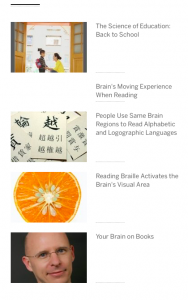Schools are Inhibiting the Introduction of Digital Technology
Technology has been quickly improving as we progress into the digital age. The digital age has introduced many new ideas and more convenient ways of retrieving information. This is leading people to spend lots of time online, whether it be for the purpose of fun or for the need of information for work or school related purposes. However, schools and workplaces have failed to adapt to these changes. Therefore, they are still using teaching methods from many years ago when our great grandparents attended school which is inhibiting children’s adjustment to the digital age we currently live in (Davidson 12). However, many argue that introducing kids to this new technology will cause them to get caught into the trap of multi-tasking which can cause various distractions. When taught properly in an environment such as schools, the introduction and use of digital technology will be very beneficial for students. It is evident that the school system needs to adapt to the digital age as it is a very beneficial source, it is a convenient way to obtain information, and it therefore allows us to see the world differently by avoiding attention blindness.
Multitasking is an obstacle that we deal with in our everyday lives. Within the digital age multitasking is very important in order to avoid attention blindness. Attention blindness is missing out on certain details because you are so focused on a given object or task, multitasking avoids this by allowing you to see everything going on and perceive the world in a different way (Davidson 4). Technology allows us to multitask in an efficient manner limiting various distractions, this should be transferred over to schools so students can learn to multitask properly. Cathy Davidson, who is a distinguished scholar of the history of technology, states in her book, Now You See It, that since attention blindness occurs so often people are unable to see each other’s sides because they are so focused on a certain topic. However, if people learned to properly multitask it would get rid of attention blindness. Technology has helped people to properly multitask and therefore it should be taught in schools (Davidson 13). Personally, I multitask frequently especially when doing homework, I find that switching between subjects when doing homework helps me to stay attentive as I am not solely doing one task. Technology has provided me an easy way of transitioning from one subject to another as they are all listed on the same website.
However, many people claim that technology is a burden to us and causes our minds to wander. Technology has distractions but everything around us is a distraction, everyone experiences distractions with every task they do each day. The digital age has not presented us with new distractions but rather the same distractions we experience already. For example, Paul La Farge, an American novelist, explains that online reading is not the only thing that makes our mind wander but rather reading itself causes the mind to space out. In the article, “The Deep Space of Digital Reading”, La Farge states, “The Internet may cause our minds to wander off, and yet a quick look at the history of books suggests that we have been wandering off all along. When we read, the eye does not progress steadily along the line of text; it alternates between saccades—little jumps—and brief stops, not unlike the movement of the mouse’s cursor across a screen of hypertext” (La Farge). Therefore, those who argue that reading online is a distraction and causes our minds to go off topic are not correct, rather reading itself is causing our minds to go off topic. However, this not only applies to reading but using the internet as a whole, there’s distractions all around us not just on the internet. For example, when I am reading a paperback book I am easily distracted by anything, whether my dog brushes past my feet or there is a lawn mower running outside I look away from the book in front of me and lose my page. We live in a world full of distractions, so the internet is not the only source distracting us.
In the current age kids already use technology on a daily basis whether its watching T.V., using social media or just simply searching the web. Hence, schools should also be providing them with technology is schools in order to succeed. Teachers, especially in high schools, should be providing their students lessons on using library databases, online tools to help students annotate and lessons on using office 365 as it is commonly used around the country. These are just a few of the many tools that should be introduced in high schools so students can use them in college and in their careers. Schools are holding their students back by not keeping them up to date with what’s going on around them. If schools introduced digital technology in their teaching methods it would help to get everyone on the same page. It would allow the world to adjust to the new age more easily and transfer it into the various career fields. From personal experience, I was never introduced to digital technology in high school, therefore within my first month of college I struggled on learning the new technology tools I was already expected to know.
Introducing the digital age to students with in schools is very beneficial as it allows them to adapt and continue to use it throughout their careers and in everyday life. It also allows them to learn the important skill of multitasking in order to get rid of attention blindness. Since schools have failed to adapt and continued the same teaching styles they’ve had for decades, students are unable to adjust to the world around them. The digital age has introduced various new technology that will help students to succeed and find the information they need in a quicker manner. Schools need to adjust because the digital age is not just going to go away rather it is going to keep improving and become a larger part of our lives. Davidson states, “The digital age is not going anywhere. It’s not going to end and it’s not going away. So, its long past due that we turn out attention to the institutions of school and work to see how we can remake them so they help us, rather than hold us back” (Davidson 13). Therefore, it’s essential for schools to adapt to technology or they are going to fall behind which will hold students back from learning.
Works Cited
Davidson, Cathy N. “Introduction.” Now You See It: How the Brain Science of Attention Will
Transform the Way We Live, Work, and Learn, Viking, 2011.
Farge, Paul La. “The Deep Space of Digital Reading.” Nautilus, 7 Jan. 2016,
nautil.us/issue/32/space/the-deep-space-of-digital-reading.






